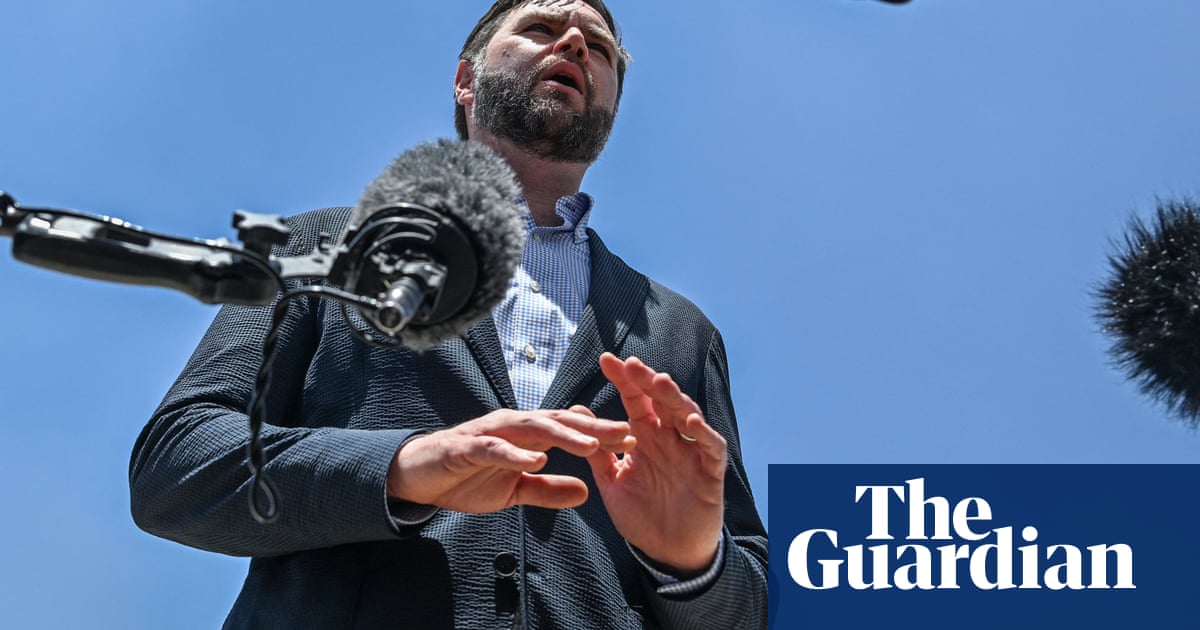The US vice-president has called onUkraineand Russia to accept a US-led peace proposal that would see the conflict frozen roughly along the current frontlines and threatened that Washington would “walk away” if it was not accepted.
Speaking on a trip to India,JD Vancesaid there would have to be “some territorial swaps” to reach a deal in public comments that came as London hosted a Ukraine peace conference that the US secretary of state, Marco Rubio, hadwithdrawn from.
“We’ve issued a very explicit proposal to both the Russians and the Ukrainians, and it’s time for them to either say yes or for the United States to walk away from this process,” Vance said.
“The only way to really stop the killing is for the armies to both put down their weapons, to freeze this thing and to get on with the business of actually building a better Russia and a better Ukraine.”
The US proposal would mean “we’re going to freeze the territorial lines at some level close to where they are today,” Vance said, though he added there should be some adjustments. “Now, of course, that means the Ukrainians and the Russians are both going to have to give up some of the territory they currently own.”
The vice-president did not explicitly mention that US would recognise Crimea, seized by Moscow in 2014, as part of Russia but reports have suggested that the concession is also part of a proposalgradually being leaked into the public domain.
A ceasefire on the current frontlines has already been accepted in principle by Ukraine and its president,Volodymyr Zelenskyy, called again for an immediate halt to the three-year war. “In Ukraine, we insist on an immediate, full and unconditional ceasefire,” he said, adding that “stopping the killings is the number one task”.
Early on Wednesday,nine people were reportedly killedwhen a Russian drone hit a bus carrying workers in the Ukrainian city of Marhanets – one of 134 large drones that Ukrainian authorities reported had attacked the country overnight.
But Russia’s demand that the US legally recognise its seizure of Crimea, a redrawing of borders by force, was rejected by Zelenskyy on Tuesday. “There is nothing new to mention or discuss. Ukraine will not recognise the occupation of Crimea,” he had said, adding that it would be incompatible with Ukraine’s constitution.
Though Ukraine has indicated it is willing to accept de facto Russian occupation of around a fifth of its territory, arguing that it will reunite the country by diplomatic means eventually, it has refused to accept what would be a domestically unpopular partition, even if the recognition was done by the US.
Other anticipated elements of the deal are that Ukraine would be prevented by a US veto from joining Nato, a point largely accepted by a reluctant Kyiv. But another that future security guarantees would be provided by a UK and French-led 30-country “coalition of the willing” has not been accepted by Russia.
Speaking to reporters on Wednesday, Putin’s spokesperson, Dmitry Peskov, said Russia continued to oppose the presence ofEuropean peacekeeping forces, which Ukraine sees as the only viable alternative to Nato membership for ensuring its security.
Peskov said there were “many nuances” surrounding negotiations to end the conflict in Ukraine and that the positions of the various parties involved had yet to be brought closer – suggesting, from a Russian perspective, that the deal was not yet agreed.
Britain had announced there would be a freshround of peace talks in Londonon Wednesday, hosted by the foreign secretary, David Lammy, and to which counterparts from the US and Ukraine had been invited plus delegations from France and Germany.
Lammy had been hoping to bring together the US, Ukraine andEuropein the peace discussions on Wednesday and so maintain relationships between traditional allies even while the direct US-Russia talks continued.
But the British minister was embarrassed by Rubio’s sudden decision late on Tuesday not to turn up and by a rising chorus of leaks apparently from the US and Russia, designed to derail the discussions and to promote the idea that the most significant discussions are those taking place directly between Washington and Moscow.
Britain said the talks had been downgraded to the level of officials and the US said it would send its Ukraine envoy, Keith Kellogg, instead of Rubio. However, Kyiv decided it would nevertheless send a senior delegation led by Andriy Yermak, Zelenskyy’s chief of staff, plus the foreign minister, Andrii Sybiha, and the defence minister, Rustem Umerov.
Initial indications suggested Russia was willing to trade territory it does not control in Ukraine – in effect, fresh air – for a US recognition of its seizure of Crimea, in what would be a formal acknowledgment that it is possible to change borders by force, creating an extraordinary post-second world war precedent.
The Kremlin’s signals are carefully calibrated and almost certainly designed to make matters difficult for Zelenskyy. Ukraine’s leadership has repeatedly signalled –as Zelenskyy repeated on Tuesday– that it could not legally recognise the seizure of Crimea or any of its other territory that Russia occupies.
Russia may be banking on the idea that Ukraine is weary after more than three years of war and that its proposal is a reasonable counter to western suggestions, backed by the US, Ukraine and Europe, that there should be an immediate and full ceasefire to allow other wider negotiations to take place.
